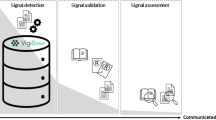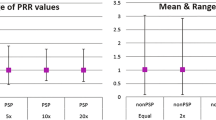Abstract
Background and aim: Statistical signal detection methods such as proportional reporting ratios (PRRs) detect many drug safety signals when applied to databases of spontaneous suspected adverse drug reactions (ADRs). Impact analysis is a tool that was developed as an aid to prioritisation of such signals. This paper describes a pilot project whereby impact analysis was simultaneously introduced into practice in a regulatory setting and tested in comparison with the existing approach.
Methods: Impact analysis was run on signals detected during a 26-week period from the UK Adverse Drug Reactions On-line Information Tracking (ADROIT) database of spontaneous ADRs that met minimum criteria (PRR ≥3.0, χ2 ≥4.0 and ≥3 reported cases) and related to established drugs (i.e. those that have been available for at least 2 years and no longer carry the ‘black triangle’ symbol). The current method of signal prioritisation (i.e. the collective judgement at a weekly meeting) was initially performed without knowledge of the findings of impact analysis. Subsequently, the meeting was presented with the findings and, where appropriate, given the opportunity to reconsider the judgement made. The categories arising from the two methods were compared and the ultimate action recorded. Inter-observer variation between scientists performing impact analysis was also assessed.
Results: Eighty-six separate signals were analysed by impact analysis, of which 5% were categorised as high priority (A), 14% as requiring further information (B), 31% as low priority (C) and 50% as no action required (D). In general, the new method tended to give a higher level of priority to signals than the existing approach. Overall, there was 59% agreement between the impact analysis and the collective judgement at the meetings (kappa statistic = 0.30). There was slightly greater agreement between impact analysis and the final action taken (kappa statistic = 0.39), indicating that the findings of an impact analysis had an influence on the outcome. Assessment of inter-observer variation demonstrated that the method is repeatable (kappa statistic for overall category = 0.77). Almost 70% of those who participated in the pilot study believed that impact analysis represented an improvement in how signals were prioritised.
Conclusions: Impact analysis is a repeatable method of signal prioritisation that tended to give a higher level of priority to signals than the standard approach and which had an influence on the ultimate outcome.







Similar content being viewed by others
References
Waller P, Heeley E, Moseley J. Impact analysis of signals detected from spontaneous adverse drug reaction reporting data (Accompanying paper). Drug Saf 2005; 28(10): 843–50
Bate A, Lindquist M, Edwards IR, et al. A Bayesian neural network method for adverse drug reaction signal generation. Eur J Clin Pharmacol. 1998; 54: 315–21
DuMouchel W. Bayesian data mining in large frequency tables, with an application to the FDA spontaneous reporting system. Am Stat 1999; 53: 177–89
Van Puijenbroek EP, Bate A, Leufkens HGM, et al. A comparison of measures of disproportionality for signal detection in spontaneous reporting systems for adverse drug reactions. Pharmacoepidemiol Drug Saf 2002; 11: 3–10
Evans SJW, Waller PC, Davis S. Use of proportional reporting ratios (PRRs) for signal generation from spontaneous adverse drug reaction reports. Pharmacoepidemiol Drug Saf 2001; 10: 483–6
Meyboom RH, Lindquist M, Egberts AC, et al. Signal selection and follow-up in pharmacovigilance. Drug Saf 2002; 25: 459–65
Bright RA, Nelson RC. Automated support for pharmacovigilance: a proposed system. Pharmacoepidemiol Drug Saf, 2002; 11: 121–5
van Puijenbroek EP, van Grootheest K, Diemont WL, et al. Determinants of signal selection in a spontaneous reporting system for adverse drug reactions. Br J Clin Pharmacol 2001; 52: 579–86
Waller PC, Lee EH. Responding to drug safety issues. Pharmacoepidemiol Drug Saf 1999; 8: 535–52
Landis JR, Koch GG. The measurement of observer agreement for categorical data. Biometrics 1977; 33: 159–74
Acknowledgements
We would like to thank the staff in the pharmacovigilance group at the Medicines and Healthcare products Regulatory Agency (MHRA) for their enthusiasm and patience throughout this project. We are grateful to Professor Stephen Evans for his discussions and Dr Lesley Wise and Mrs Eugenia Yoannou for their support and assistance. We also thank Peter Waller for his help in developing a computer program to facilitate impact analysis.
Funding was provided internally by the MHRA. The authors have no conflicts of interest that are directly relevant to the content of this study.
Author information
Authors and Affiliations
Rights and permissions
About this article
Cite this article
Heeley, E., Waller, P. & Moseley, J. Testing and Implementing Signal Impact Analysis in a Regulatory Setting. Drug-Safety 28, 901–906 (2005). https://doi.org/10.2165/00002018-200528100-00006
Published:
Issue Date:
DOI: https://doi.org/10.2165/00002018-200528100-00006




